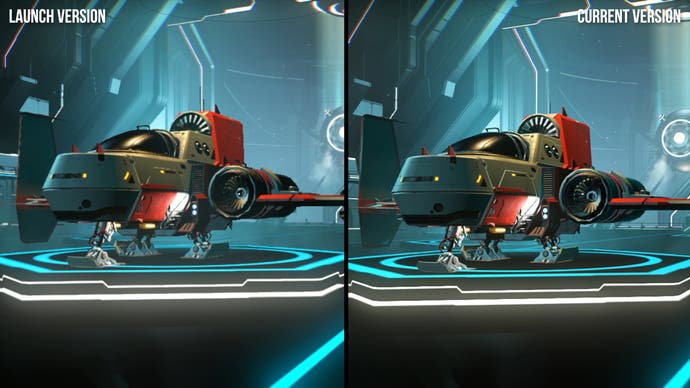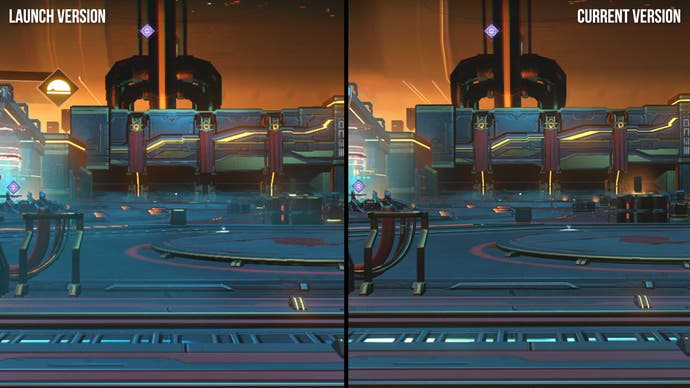Best graphics on Nintendo Switch: seven years of third-party developer brilliance

Impossible ports. That phrase is our shorthand for the conversion of console and PC titles to the Switch that seem almost inconceivable, pushing the aging Tegra X1 hardware in the seven-year-old Nintendo handheld to its absolute limits. That’s what we’re focusing on today as we round up the best-looking and most technically accomplished third-party releases on Switch, following on from our retrospective of the best-looking first-party Nintendo releases last month.
As well as the impossible ports, we’ve rounded up a surfeit of other games that impressed on launch – or have been substantially improved by later upgrades – to become some of the most incredible-looking games on the platform. We’re talking Doom, we’re talking Crysis, and plenty more too. There are even some great Switch releases that go beyond their home console equivalents, adding more modern TAA (temporal anti-aliasing) and other features to make Switch the premiere place to experience some titles. There are a huge variety of genres and game engines represented on the list, and it’s fascinating to see what techniques developers used to make the most of the Switch platform.
We’ll start with the meatiest category: the impossible ports, the graphically intense or wide-ranging games that we couldn’t quite believe would make the transition to Switch intact – but did. The archetypal example here is undoubtedly The Witcher 3, as its graphical fidelity and huge open world meant that even the home console versions on PS4 and Xbox One were pushed extremely hard – often well below 30fps. With the Switch operating on a meagre power budget thanks to its portable nature, realising that vision on the Switch seemed a daunting prospect – but original developers CDPR and porting studio Saber Interactive somehow made it work.
The cutbacks from the other console versions to Switch are far-ranging, with cuts to resolution, shadows, reflections, LODs and many other settings. Yet the core visual character of the game remains intact, with impressive water and environments, and performance is a surprisingly stable 30fps outside of CPU-heavy areas like the city of Novigrad. Playing on portable mode minimises the effect of the lower resolution, and having what is a hugely long and dense game in the palm of your hand is pretty special. The developers have even added in options to disable more effects like AA and bloom to help push better performance, and with an overclocked Switch 60fps is within the realms of possibility – an incredible turnout.
Nier Automata is another game that felt too good to be true on Switch, especially when the Xbox One release often fell well below its 60fps target – but the Switch port is surprisingly excellent. A big part of that is the decision to go for a stable 30fps, which allowed the developers to adapt what is quite a wide-ranging title in terms of gameplay into one that is remarkably stable on Switch and looks extremely similar to the Xbox One and PS4 releases.
There are some standard cuts here – like lower-res textures and effects – but also some more novel stuff, such as replacing the 3D polygonal grass with alpha-tested foliage, that looks different but arguably better thanks to its cleaner edges! There’s also better anti-aliasing on Switch, which looks to include temporal data, resulting in a more stable image than on PS4 or Xbox One.
Ace Combat 7 is another title that far exceeded expectations when it was released on Switch earlier this year, especially in the face of minimal promotion from its publisher. Unreal Engine 4 games often run poorly on Switch – or suffer from extremely low internal resolutions – so it was a relief to see a game that looks much the same on Switch as elsewhere, with sensible cutbacks that leave key visual features like cloud rendering intact at a stable 30fps. It even includes a 1080p HUD for docked play that exceeds that of last-gen consoles, and arguably it’s the better release overall.
We saw a similar spirit from the porting team at work on Dragon Quest 11, who went even further in terms of almost recreating a lot of foundational elements of the game to craft a solid Switch release. That includes redoing textures, reimplementing the lighting and pulling in LODs, making for a game that looks different rather than worse. Interestingly, it was this Switch version that was used as the basis for ports to current-gen platforms, rather than the ostensibly higher fidelity PS4 and Xbox One version that’s now stuck on these platforms.
Hellblade: Senua’s Sacrifice took a rather unusual step by opting for pre-rendered cutscenes on Switch versus the in-engine examples used on other platforms, a decision that makes sense given the heavy (and typically expensive) post processing the game is known for. Despite a lower resolution and settings cuts, Hellblade still feels intact on Switch during gameplay and even includes the binaural audio that sets its soundscape apart.



The final game in our self-declared impossible ports category is No Man’s Sky. This game underwhelmed on debut, with a muddy, low-resolution look, but was massively improved in 2023 thanks to the inclusion of a custom version of AMD’s FSR 2 upscaling. That addition proved transformative for the game, turning it into one of the cleanest-looking and most visually stable games on the platform. Some of the changes made in the recent Worlds Part 1 also made their way to Switch, so water has a proper geometric surface now and there’s more variety in terms of flora and fauna. Performance still isn’t perfect, and pop-in issues are still noticeable, but it’s still a huge turnaround that is one of the most impressive in the Switch’s history.
Doom is a series that might not immediately come to mind when it comes to graphically intense games, but it is remarkable that the entire series is playable – and indeed quite good! – on Switch. There are great ports on the classics, Doom 1 and Doom 2, and Doom 3’s dark flashlight-lit corridors are the perfect fit for the inky blacks of the Switch OLED – even if performance sometimes drops below a locked 60fps.
The modern Doom releases also play well on the system, with Doom (2016) being another game that seemed almost inconceivable for Switch but was carefully chainsawed into submission less than a year into the system’s lifespan. The resolution is lower, the action is restrained to 30fps, but all of the key visual features are intact: depth of field, motion blur, materials. The game particularly impresses in docked mode, where the lower resolution is less of an issue, and really helped stretch the definition of what Switch hardware was capable of.
Doom Eternal is a much bigger and more demanding game than its predecessor, yet it plays great on Switch too. Motion blur and some other post processing effects are sacrificed, which is a shame, but the game’s much larger combat arenas and intense asset variety make the jump intact to the Nintendo handheld. In fact, Eternal tends to run a bit better than Doom (2016), with a higher frame-rate and better frame pacing, which is a huge achievement from port specialists Panic Button. The next Doom game might not make it to Switch, but the Doom selection for Switch is still hugely impressive.
The Switch is also surprisingly a great place to play through the three mainline Crysis games, with ports of all three titles that sometimes exceed what was done on PlayStation 4 and Xbox One back in the day. Developers Crytek and Saber Interactive performed perhaps their best work on Switch with the first game in the series, as it sports a level of physicalised destruction that is rare even in modern titles on more powerful hardware. Add in the massive maps, and it’s a surprise that Saber had the headroom to add in SVOGI (software-based real-time global illumination tech), parallax occlusion mapping and TAA (temporal anti-aliasing) while keeping frame-rates at reasonable levels.
All three games in the series run well on Switch though, and while Crysis 3 doesn’t see as much of an uplift versus the console originals thanks to a higher level of baseline fidelity, the TAA is still improved and performance is better across the board. These are all truly impressive ports for a handheld system – and of course, it’s just fun to be able to affirmatively answer the question “but does it run Crysis?”
Please enable JavaScript to use our comparison tools.
Beyond these well-worn series, there are a handful of miscellaneous games that deserve a mention on Switch. Yooka-Laylee, Team Sonic Racing, Virtua Racing and Ori and The Will of the Wisps are all great performers on Switch, largely down to careful architecting for Switch hardware in particular. Yooka-Laylee smartly chose Switch as the base platform for their development efforts, then scaled the game up for more powerful hardware – rather than trying to cut down a design intended for home consoles, as we normally expect to see. Virtua Racing is another game that was essentially redone from the ground up to take full advantage of Switch hardware, and is one of the very few games to support eight-player split-screen on the system – an incredible feat even given the retro graphics. It’s always easier to just turn down settings and crunch down the resolution for a Switch port, but these games prove that there’s huge scope for improvement if you take a more purposeful approach.
There are also a handful of games that truly benefitted from adding TAA, transforming somewhat problematic initial console releases into much better-looking and more visually stable games thanks to the use of a technology that wasn’t widespread on PS3 and Xbox 360 a decade ago. Alien Isolation, Metro Redux and Dying Light all fall into this category, with the dark environments found in these games also benefitting from the Switch OLED display.
Seventh-gen console games in general are a fertile ground for Switch portery, with Burnout Paradise, Grid Autosport, Portal and Portal 2 all transferring naturally to a modern handheld. Often, a stable 60fps is possible in games that didn’t quite manage that update rate, while fidelity can also be improved using more modern techniques.
Our final category comprises Rebellion’s Switch releases, proving that you don’t need to have a huge amount of resources to do a great conversion. Sniper Elite 3, Sniper Elite 4 and Zombie Army 4 look remarkably similar on Switch as on home consoles, with their trademark slow motion x-ray kill cams and SSR intact, with only minor reductions to elements like post-processing and lighting.
Again, it seems to be the case that care and attention are the true defining features of a successful Switch adapation; knowing what to keep and what to drop based on the essential qualities of the game and the hardware capabilities of the Switch.
With that in mind, it’s hard to pick a single winner, the best impossible port for Switch. All of the games mentioned have achieved more than we thought possible when the Switch was initially announced, and ought to applauded for their technical feats. Similarly, Nintendo has done excellently to deliver significantly more performance potential than we ever saw on the Nvidia Shield devices that run, on paper, faster versions of the same Tegra X1 processor. It’ll be facinating to see how the next Nintendo console fares – it’ll surely be more powerful, so we could be on the brink of a whole new wave of impossible ports.




